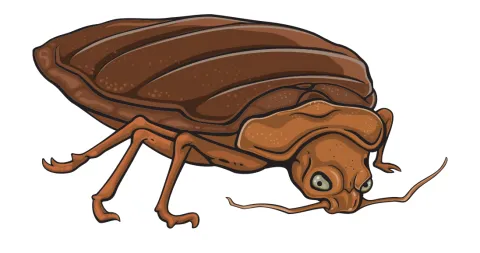
Bed bugs (Cimex lectularius) are nuisance insects that feed on the blood of humans and other warm-blooded animals (including birds, rodents, bats and pets).
Bed bugs are not exclusively nocturnal but are mostly active at night.
Adult bed bugs are oval-shaped, smaller than an apple seed, wingless and reddish-brown in color. They are not known to transmit disease.
Where do bed bugs live?
Bed bugs hide during the day in dark, protected areas.
- Cracks and crevices
- Windows
- Door frames
- Mattresses
- Picture frames
- Loose wallpaper
- Baseboards
Bed bugs can not travel far. They are transported by humans by latching on to luggage, clothing, bedding and furniture.
The chance of a bed bug infestation is higher when there's a high rate of occupant turnover, such as in hotels, shelters, airplanes, trains and apartments.
Infestations are not typically a reflection of poor hygiene or housekeeping.
How do I know if I have bed bugs?
- An infestation can be recognized by reddish or black stains on bedding, walls or furniture from fecal matter, crushed bugs, or from blood stains caused by feeding. Signs of bedbugs»
- A sweet, musty odor (like over-ripe raspberries)
- Physical symptoms of bites, such as itchiness, inflammation and welts on the skin.
Many insects can cause similar skin reactions. If an allergic reaction occurs, contact your health care provider.
Who should I call to identify bed bugs?
Call Multnomah County's Bed Bug Information Line, 503-988-BUGS (2847) if you think you may have an infestation.
How do I control bed bugs?
Bed bug infestations can be controlled by following an integrated pest management approach. This uses multiple treatment methods and emphasizes minimal use of potentially harmful chemicals.
Prevention
- Routinely inspect for and detect bed bugs.
- Inspect traveler’s clothing and luggage; keep infested items out.
- Seal exterior cracks and crevices, repair screens on doors and windows.
- Reduce clutter in the home.
- Use a bed bug-approved mattress cover.
Virginia Tech University has a helpful guide for preventing bed bugs»
Sanitation
- Launder bedding and clothing in hot water. You can also use a dryer on the highest heat setting the fabric will tolerate.
- Frequently vacuum mattresses and premises; immediately seal vacuum bags and discard in an outdoor trash bin.
- Carefully scrub mattress seams and bed frames to remove bed bug adults and eggs.
- Seal mattress or consider discarding mattresses in severe cases.
Insecticides
- Insecticides can make people sick. How to use insecticides safely»
- Select a licensed professional to apply insecticides for the control of bed bugs in all life stages (egg to adult). Tips for selecting a pest professional»
- Insecticides should only be applied according to the manufacturer’s instructions. Be sure you have material safety data sheets (MSDS) and other precaution information before starting.
For group quarters
- Properly train staff on how to prevent and reduce bed bug infestations and communicate to residents.
- Create a detailed procedure for staff and residents to follow if they feel they have been exposed to bed bugs.
How should I handle an infestation if multiple persons could be exposed to bed bugs?
Immediately respond to potential bed bug complaints. Keep a list of actions taken to resolve the problem.
Helpful Documents
- DocumentBed Bug Q&A (50.46 KB)
- DocumentTenants' Rights and Bed Bugs (83.72 KB)
- DocumentBed Bug Poster (48.16 KB)
- DocumentBed Bug Brochure (2.04 MB)
- DocumentBed Bug Brochure En Espanol (703.84 KB)
More Information
EPA Bed Bug Pesticide Information
University of Minnesota Bed Bug Information:
Multnomah County Bed Bug Information Line
503-988-BUGS (2847)
